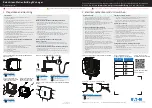
1. When applying the brakes, the vehicle body shakes back and forth. The seriousness of the shaking is not
influenced by vehicle speed.
Brake Pedal Vibration
1. When applying brakes, a pulsating force tries to push the brake pad back. The pulsation is transmitted to
the brake pedal.
2. The following are the main possible causes of brake judder:
Due To An Excessive Runout (Side-To-Side Wobble) Of The Disc Plate, The Thickness Of The Disc Plate Is Uneven
1. If the runout is
more than 0.05 mm {0.002 in}
at the position
10 mm {0.39 in}
from the disc plate edge,
uneven wear occurs on the disc plate because the pad contacts the plate unevenly.
2. If the runout is
less than 0.05 mm {0.002 in}
, uneven wear does not occur.
The Disc Plate Is Deformed By Heat
1. Repeated panic braking may raise the temperature in some portions of disc plate by
approx. 1,000°C
{1,832°F}
. This results in a deformed disc plate.
Due To Corrosion, The Thickness And Friction Coefficient Of Disc Plate Change
1. If a vehicle is parked in damp conditions for a long time, corrosion occurs on the friction surface of disc
plate.
2. The thickness of corrosion is uneven and sometimes appears like a wave pattern, which changes the
friction coefficient and causes a reaction force.
Inspection and Repair Procedure
2007 Mazda MX-5 Miata Sport
2007 BRAKES Conventional Brake System - MX-5 Miata
Microsoft
Thursday, July 09, 2009 3:18:52 PM
Page 33
© 2005 Mitchell Repair Information Company, LLC.
















































